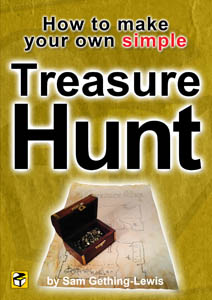
How to Make Your Own Treasure Hunt
Here are a few ideas to help you make your own treasure hunt. If you have any stories, ideas or thoughts you’d like to contribute to this page then please leave your comments.

Here is a FREE e-book of How to make your own simple Treasure Hunt.
The Basics
The most important thing to consider when you make your own treasure hunt is to plan everything in advance.
Get or make a map of the area you will be using (detailed instructions in the e-book).
Decide how many clues there will be by working out the amount of time you would like the whole activity to take, and then splitting it into the amount of time it will take to travel to the location and solve the clue. For example, if you had 2 hours in a 4 acre area then you could reasonably spend 5 minutes getting to each clue, 10 minutes to solve it making it an 8 clue hunt.
You can either have a papertrail version, which is a linear based system, or a set clue version, giving the intrepid hunters all the clues to solve in whichever order they can.
Ask yourself what the hunt is for: it can be used to get messages across to the participants, teach them the history of the location, about your product, or just for fun. Next we take the final objective and work backwards.
Consider whether you want just one winner or many winners.
If we stick with the 8 clue example, you could make your own treasure hunt with any of these to give you a final answer:
- Crossword
- Wordsearch
- Wordgrid
- Map Names
The final answer can either qualify participants for a reward or inform them of the final location. This is easiest to do using the wordsearch as you can hide a lengthy final solution.
To make your own treasure hunt try to use permanent fixtures or anchors that cannot change between the time you write the treasure hunt, the time people start to take part and beyond, particularly if it is going to exist over a long period of time or if it can be tampered with.
When positioning the clues, make sure that they aren’t going to be solved in a wide open space so other participants can see other people’s reactions or methods of solving them. When writing the clues, keep the whole treasure hunt interesting by having a different style of challenge each time, stimulating all the senses.
Make sure the answers are definitive and clear. You can’t have more than one right answer.
Do a dry run of the hunt, or even better, get someone independent to test it to iron out any unforseen glitches that may occur.
Just before you actually launch the treasure hunt, cast your eye around the clue locations to make sure nothing is obscured or tampered with.

Leave a Reply